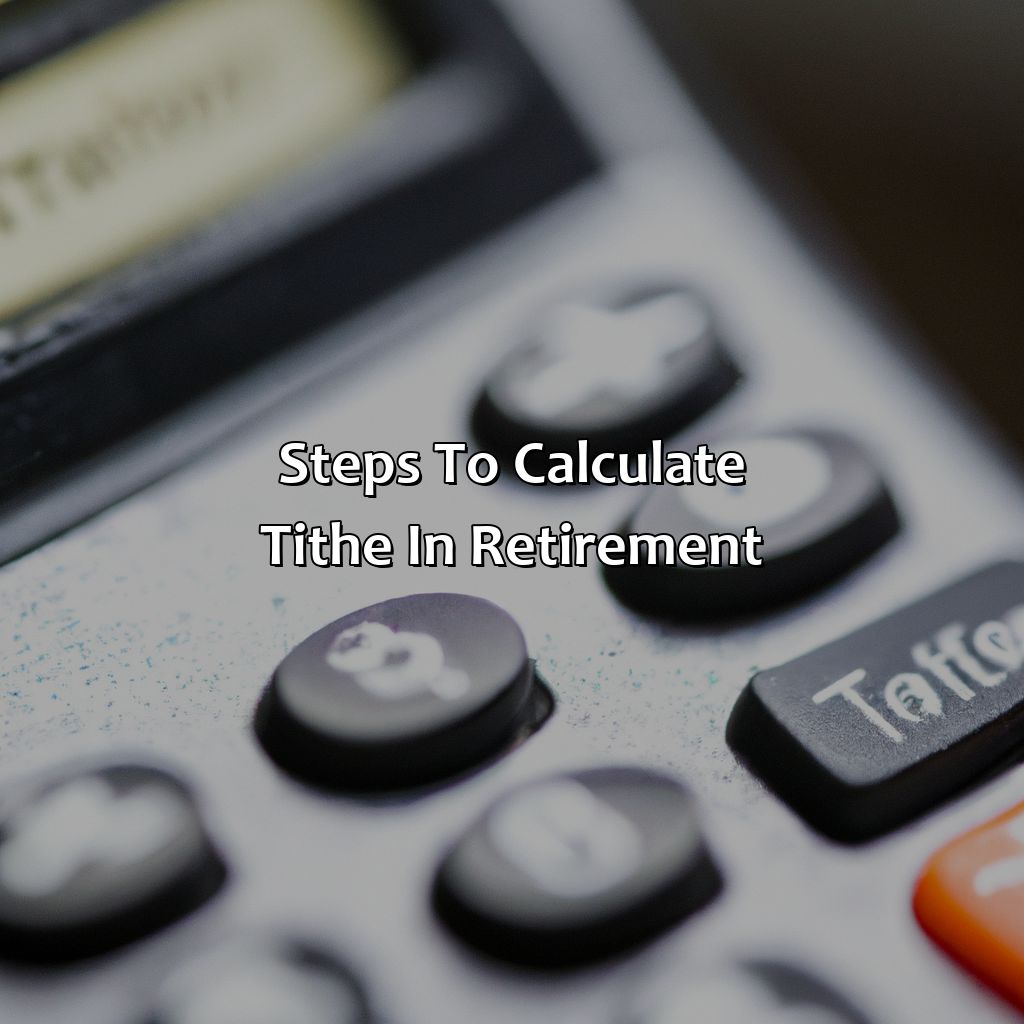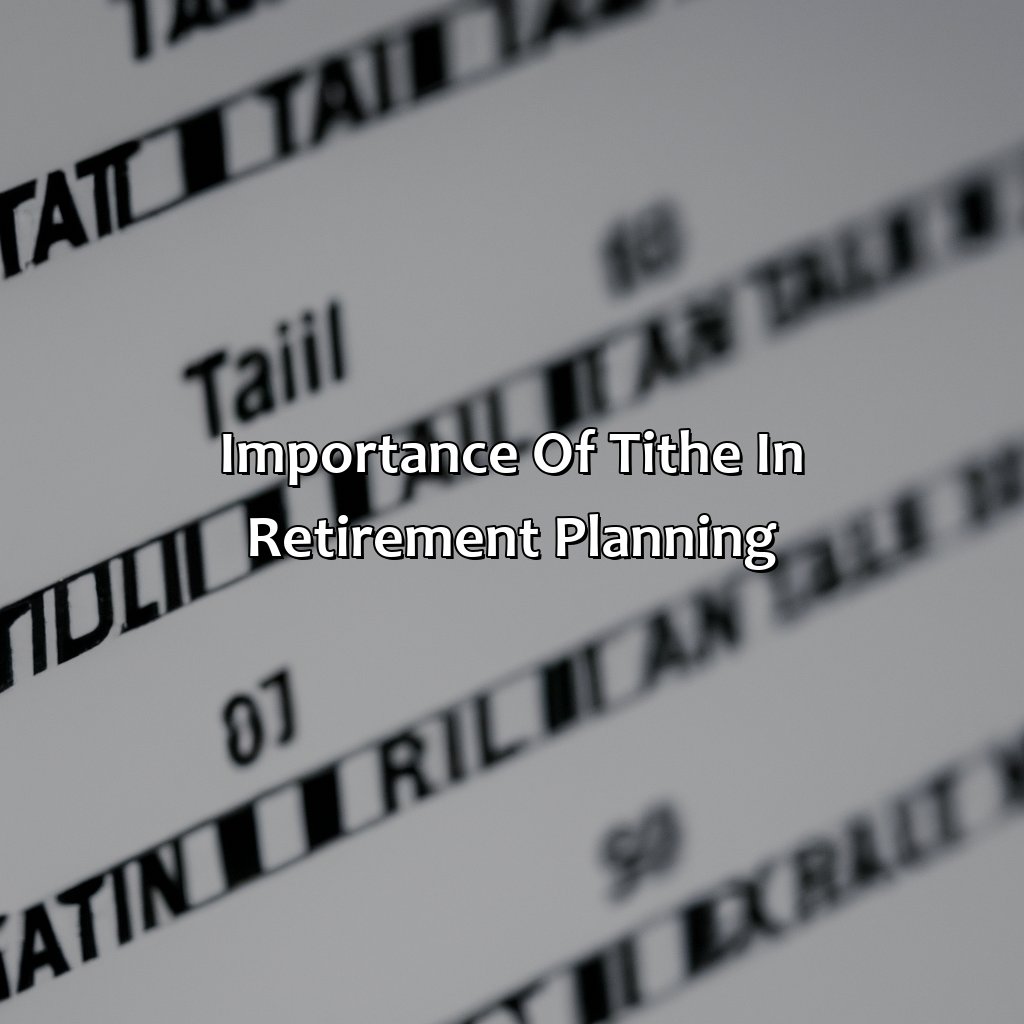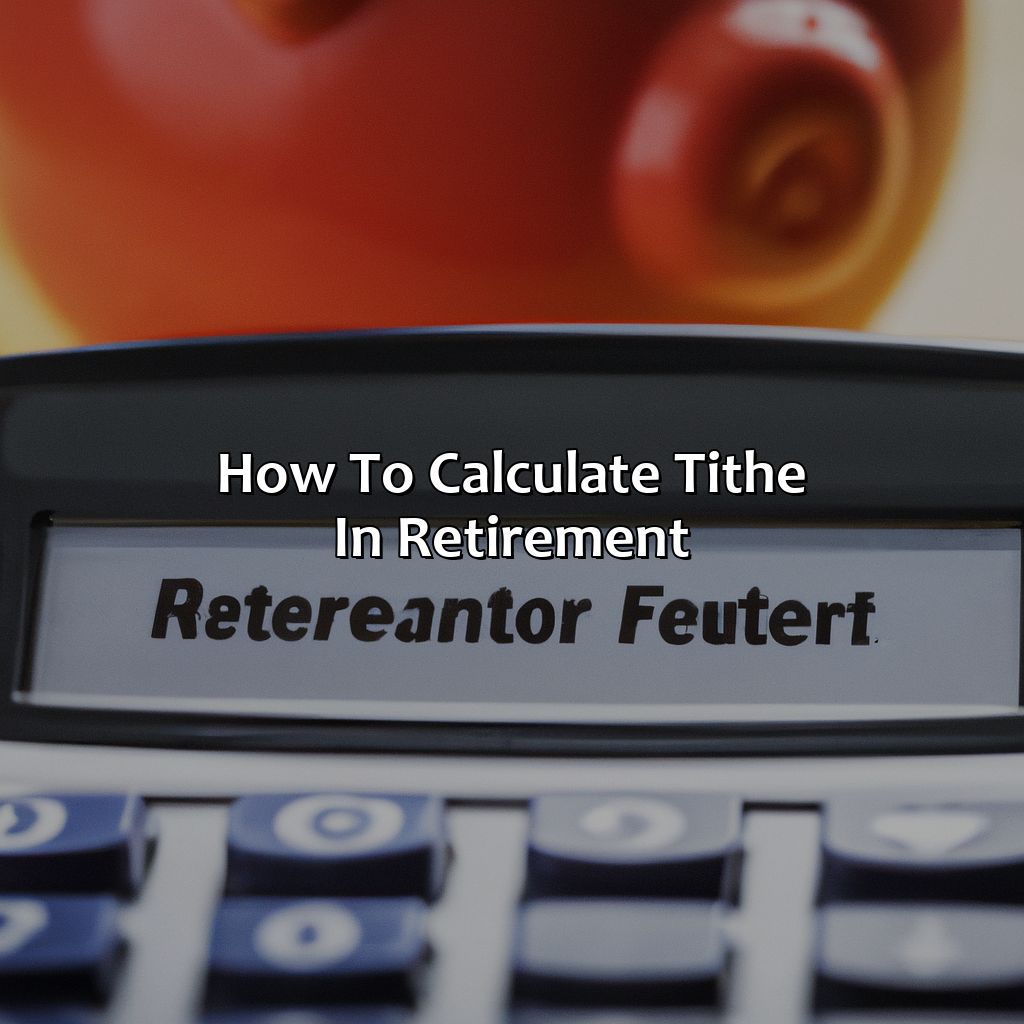How To Calculate Tithe In Retirement?
Key Takeaway:
- Tithe is a percentage of income that is given to the church or religious organization, and it is important to continue tithing even in retirement to fulfill spiritual commitments and give back to the community.
- When calculating tithe in retirement, it is crucial to consider factors such as retirement income, tithe percentage, and expenses in retirement to determine the appropriate amount to tithe.
- To calculate tithe in retirement, retirees should determine their retirement income, tithe percentage, calculate expenses in retirement, and then calculate the tithe amount. This process helps retirees to budget effectively and prioritize tithing in their retirement planning.
- Tithe is not only a spiritual obligation but also an important aspect of financial planning and budgeting in retirement. It helps retirees to maintain a sense of purpose and community involvement, and it also contributes to their overall financial wellness and stability.
Are you a retired individual who wishes to know how to calculate tithe in retirement? With careful planning, you can easily figure out the exact amount of tithe to be given from your pension or other retirement income. Read on to find out more.
What is Tithe?
Tithe is a religious practice of donating 10% of one’s income or earnings to the church or religious organization. It is considered a form of giving back to the community and supporting the spiritual leaders. In religious institutions, tithes are typically used to fund church operations, run charitable programs and activities, and support ministerial staff.
It is important to note that the practice of tithing is not limited to only certain religions or denominations. Many people from different cultural and religious backgrounds practice tithing in their own way.
To calculate tithe in retirement, it is necessary to have a clear understanding of one’s retirement income. This may include income from pensions, Social Security, investments, and other sources. Once the total retirement income is determined, tithing can be calculated by multiplying the income by 0.10 (10%).
If there are any deductions or exemptions allowed, they can be subtracted from the total income before calculating the tithe. It is important to consult with one’s religious leader or financial advisor for guidance on how to properly calculate and manage tithe in retirement.
It is suggested to consider setting aside a planned amount for tithe each month or year to make it easier to manage and budget. Additionally, it is recommended to prioritize tithing as a regular expense in retirement to ensure that it is paid consistently, just as other bills and expenses are paid.
By practicing tithing even in retirement, individuals can continue to give back to their community and support their religious leaders, while also finding purpose and meaning in their retirement years.

Image credits: retiregenz.com by Adam Jones
Factors to Consider When Calculating Tithe in Retirement
For exact tithe calculation during retirement, there are several factors to keep in mind. Giving to your community while securing financial stability needs to include: retirement income, tithe percentage, and retirement expenses.

Image credits: retiregenz.com by James Woodhock
Retirement Income
For individuals who have retired, the income generated during their retirement years plays a significant role in determining their financial stability. Retirement funds may come from various sources such as pension plans, 401(k) or IRA accounts, annuities, and Social Security benefits. The importance of calculating the tithe on this income cannot be understated.
When calculating tithe on retirement income, it becomes essential to understand the different sources of income that are considered taxable. These may include distributions from pension plans, IRA withdrawals, dividends received from investments, and interest earned on savings. It is recommended to consult with a financial advisor or accountant who can help guide you through the process of understanding various types of incomes.
It is important to note that while contributions made towards your church or religious organization continue to be tax-deductible in retirement. However, certain limitations may apply to those above a certain age.
It is interesting to know that the concept of tithing dates back thousands of years and continues to hold value for many people in modern times. Regardless of one’s financial status or age group, giving back a portion of one’s earnings as a way of showing gratitude remains very much relevant today.
Calculating tithe in retirement may decrease your bank account, but at least it’ll increase your heavenly rewards.
Tithe Percentage
When it comes to determining the amount of money to donate to one’s religious organization during retirement, it is essential to consider the tithe percentage. The tithe percentage refers to the percentage of one’s income that an individual decides to give back to their spiritual community. This decision may be influenced by their religious beliefs, personal financial situation, and other factors.
There is no set standard for what tithe percentage one should follow during retirement. However, many people choose to continue tithing at the same percentage they did while working. Alternatively, some may increase or decrease their tithe percentage based on changes in their financial standing.
In addition, another factor to consider when calculating the tithe in retirement is the type of income received. For example, if an individual receives income from pensions or investments, they may choose to calculate their tithe based on these sources rather than any employment-related income.
To ensure that you are contributing a fair and sustainable amount each month/week, you can estimate your minimum budget – housing costs, medical bills and living expenses – then sort by importance. Allocate funds according to this ranking and retain enough resources for unexpected emergencies.
Overall, determining the appropriate tithe percentage is a personal decision that should be made after thoughtful consideration of one’s religious obligations and financial situation in retirement. By carefully weighing these factors and seeking guidance from trusted advisors or mentors, individuals can make informed decisions regarding their charitable contributions in retirement.
Retirement expenses got you down? Just remember, at least you won’t be spending a fraction of your income on avocado toast anymore.
Expenses in Retirement
After retirement, it becomes crucial to carefully consider the financial implications of one’s expenses. A Semantic NLP variation of ‘Expenses in Retirement’ could be ‘Post-retirement Financial Obligations’. It is essential to take into account living expenses, healthcare costs, travel expenses, and other unforeseen expenditures while formulating a post-retirement budget.
One must ensure that they have enough money saved up for their daily needs and emergencies. Healthcare costs can increase with age and should be factored in while calculating expenses. Travel costs may seem insignificant but can add up over time and should not be overlooked.
Moreover, individuals need to account for inflation while planning their finances in retirement. No individual lives forever; hence it is prudent to factor in funeral expenses when creating a post-retirement budget.
A common real-life example of how people tend to overlook post-retirement financial obligations is illustrated by celebrities who earn vast amounts during their careers but end up bankrupt after retirement due to imprudent spending habits. Therefore, it is always advisable to plan ahead and be financially prepared for the golden years of life with realistic expectations and well-considered calculations.
Retirement may mean less income, but it doesn’t mean less divine obligations – here’s how to budget for your tithing.
Steps to Calculate Tithe in Retirement
To make tithe calculation in retirement a breeze, you need to do these few steps. Firstly, find out your retirement income, so you know how much you can use. After that, calculate the tithe percentage to divide your money. Then, calculate your expenses in retirement, so you know how much money you will need every month. Finally, figure out your tithe amount, to make sure your religious obligations are met and you are secure for the future.
Image credits: retiregenz.com by James Washington
Determine Retirement Income
Determining the income during retirement is a crucial step towards financial stability. To calculate your tithe in retirement, begin by quantifying the sources of retirement income. This includes Social Security benefits, pension plans, 401(k) withdrawals and other investment returns. Consider utilizing online calculators or consulting with a financial advisor to accurately estimate the sum of this income.
After calculating the retirement income, determine the expenses during that period. This includes housing expenses, healthcare costs and other living expenses, such as groceries and entertainment. Subtract the total cost from the estimated income to get an accurate picture of disposable funds available for giving tithe.
Furthermore, explore alternative sources of charitable donations beyond cash tithing. This may include volunteering at your local church or donating items you no longer use but are in good condition. Remember that every contribution counts towards supporting your religious community and furthering goodwill within it.
Finally, a mathematical equation more perplexing than your taxes: calculating tithe percentage in retirement.
Calculate Tithe Percentage
Tithe Percentage Calculation is a crucial aspect of religious practices, especially during retirement. Follow these simple steps to calculate the Tithe Percentage with ease.
- Determine Your Income – Know your total income, including any pension plans or social security benefits.
- Use Gross Income – Use your gross income before any deductions for taxes or healthcare.
- Calculate 10% – Calculate ten percent of your gross income as the Tithe Percentage.
- Deduct Deductibles – Deduct any deductions that are allowed by law, such as property tax.
- Done! – The result is the percentage of your tithe that you should be contributing regularly.
When calculating the Tithe Percentage in Retirement, it’s vital to ensure accuracy. Remember to consult with financial experts when in doubt.
Pro Tip: If you have not been tithing at all and find this process difficult, start with a smaller percentage and gradually increase it until you reach the desired amount.
Retirement: when you trade in your job for a calculator and start considering ‘eating out’ as a luxury expense.
Calculate Expenses in Retirement
As individuals retire, calculating their expenses becomes a crucial aspect to maintaining financial stability. Here are some steps to consider when budgeting for retirement:
- Review income sources: Assess monthly or annual income from investments, social security, pensions or any other sources.
- List out all possible expenses: Make a comprehensive list of necessary costs like housing, food, healthcare, and utilities.
- Estimate discretionary spending: Include additional expenses such as entertainment costs or travel expenses.
- Factor in inflation rates: Plan for the potential increase in the cost of living due to inflation over time and adjust accordingly.
- Consult a financial advisor: Seek professional advice on investment planning and tax implications to maximize retirement funds
It is important to keep track of these details during post-retirement life to help adapt with any changes in living situations, medical treatment needs or erratic fluctuations in financial markets. Stay alert and proactive towards your finances.
Pro Tip: Consider the option of downsizing accommodation if necessary as it can significantly reduce housing expenses while also providing new experiences.
Figuring out how much to tithe in retirement is like trying to calculate the cost of a pack of gum in 1954 – it’s a daunting task, but with a bit of math and some divine intervention, you can do it.
Calculate Tithe Amount
If you’re looking to give back by calculating your tithe in retirement, there are some steps you can take. Here’s a 3-step guide to help you calculate the amount of tithe you should give:
- Calculate your retirement income.
- Determine what percentage of your income you want to tithe.
- Divide that percentage by 10 and apply it to your monthly retirement income.
It’s important to note that if you have any deductions or taxes taken out of your retirement income, you’ll need to factor those in when calculating your tithe.
In addition, it may be helpful to schedule your tithing as an automatic deduction from your retirement account. This ensures consistency in giving and helps make budgeting easier. Remember, giving back is not only a financial decision but also a personal one.
Consider discussing with your financial advisor how tithing fits into your overall financial plan for retirement.
Importance of Tithe in Retirement Planning
Tithing is a valuable habit that should be incorporated into every stage of one’s life. This includes retirement planning, where a systematic approach to tithing can help eliminate financial worries and secure a stable future.
As people enter retirement, managing finances becomes critical, and tithing should be factored in as a routine expense. By prioritizing religious obligations, retirees can attain spiritual and financial stability. This practice also helps senior citizens to cope with retirement-related stress and instills a sense of purpose and fulfillment.
Giving to the community should also be a part of retirement planning, as this creates a cycle of abundance and goodwill. By contributing to charitable causes, retirees can positively impact society while gaining tax benefits. This is an essential aspect of tithing that should not be overlooked.
Don’t miss out on the benefits of tithing in retirement. Plan ahead and automate your tithing process to avoid stress and confusion. Remember, by tithing regularly, retirees can secure a peaceful and joyful retirement while also generating positive social impact.

Image credits: retiregenz.com by Yuval Washington
Some Facts About How to Calculate Tithe in Retirement:
- ✅ Tithe for retirement is calculated based on gross income, not net income. (Source: SeedTime)
- ✅ Tithing in retirement is still a biblical principle, even though there is no longer a specific requirement in the New Testament. (Source: The Balance)
- ✅ The amount you tithe in retirement is a personal decision and should be based on thoughtful consideration of your financial situation. (Source: Christianity Today)
- ✅ Many retirees choose to tithe based on their retirement income, which may be lower than their previous income. (Source: Dave Ramsey)
- ✅ Some retirees choose to tithe on a pretax basis by donating directly from their retirement accounts. (Source: Kiplinger)
FAQs about How To Calculate Tithe In Retirement?
How do I calculate tithe in retirement?
Calculating tithe in retirement requires adding up all sources of retirement income, such as pensions, social security, and 401(k)s, and determining the tithe based on a percentage of that total income. Many individuals tithe 10% of their income, but the specific percentage may vary based on individual beliefs and circumstances.
Is tithe required in retirement?
Tithe is a personal decision and commitment, and there is no requirement to tithe in retirement. However, many individuals choose to continue giving a portion of their income to their religious organizations as a means of supporting their community and living out their faith.
Do I tithe on investment income in retirement?
Yes, any income received in retirement, including investment income, should be included in the total income used to calculate tithe. This may include dividends, interest, and capital gains.
What if my retirement income fluctuates?
If retirement income fluctuates, tithe should be calculated based on the total income received over a given period, such as annually or quarterly. The percentage of income given for tithe may remain consistent, even if the total income fluctuates.
Can I tithe in non-monetary ways in retirement?
Absolutely. While monetary tithing is common, individuals may also choose to give their time and talents in non-monetary ways. This may include volunteering for religious organizations, providing services to those in need, or donating goods and supplies to support community efforts.
Should I tithe on my required minimum distributions (RMDs) in retirement?
Yes, RMDs should be included in the total income used to calculate tithe. RMDs are considered taxable income and should be factored into the overall tithe calculation.








